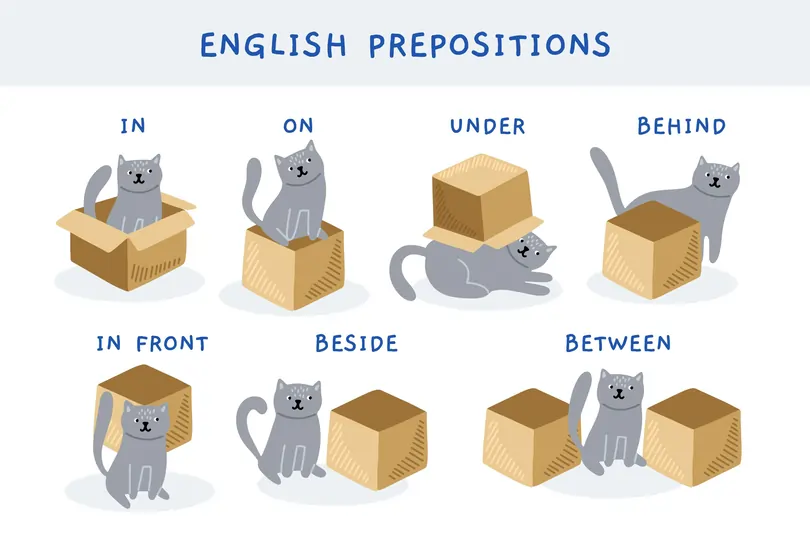Prepositions: A complete guide

Image by Freepik
Prepositions, those seemingly small words, play a vital role in connecting words and phrases, giving your sentences the necessary context and structure. In this guide, we will delve deep into the world of prepositions, providing you with a solid understanding of their usage and idiomatic expressions.
What are Prepositions?
Prepositions are words that help us understand the position, direction, time, or relationship between different things in a sentence. They give context and help us create clear and accurate descriptions.
Here are some examples:
-
Location: Prepositions like "in," "on," and "under" tell us where something is located. For instance, "The book is on the table."
-
Direction: Prepositions like "to," "towards," and "across" show movement or direction. For example, "She walked to the park."
-
Time: Prepositions like "before," "after," and "during" indicate when something happens. For instance, "We'll meet after the movie."
-
Manner: Prepositions like "with," "like," and "by" describe how something is done. For example, "He painted the wall with a brush."
-
Possession: Prepositions like "of" show ownership or possession. For instance, "The hat of the girl is pink."
Prepositions are important because they help us build clear and meaningful sentences by providing details about the relationships between different parts of a sentence.
Prepositions and sentence structure
Understanding prepositions is crucial for maintaining proper sentence structure. Prepositions are often followed by nouns or pronouns. Example: She walked to the store.
101 Most common prepositions and their usage
Prepositions of location
1. In: Used to express location within a defined space or time. Example: The book is in the bag.
2. On: Indicates a position upon a surface or contact with something. Example: The cup is on the table.
3. Under: Signifies a position below or beneath something. Example: The cat is under the chair.
4. Above: Shows a position higher than something else. Example: The plane is flying above the clouds.
5. Below: Refers to a position lower than something else. Example: The fish is swimming below the surface.
6. Beside: Indicates a position next to or alongside something. Example: She sat beside her friend.
7. Between: Denotes a position in the middle of two or more things. Example: The sandwich is between the two plates.
8. Among: Represents a position within a group or surrounded by things. Example: The flowers are among the trees.
9. Near: Indicates a close proximity to something. Example: The store is near the park.
10. Far: Signifies a considerable distance from something. Example: The mountain is far from here.
11. At: Used to express a specific location or point in time. Example: I'll meet you at the restaurant.
12. By: Indicates the agent performing an action or a means of achieving something. Example: The book was written by the author.
13. With: Specifies accompaniment or association with someone or something. Example: He went to the party with his friends.
14. Without: Describes the absence or lack of something. Example: She completed the task without help.
15. Inside: Refers to a position within an enclosed space. Example: The keys are inside the drawer.
16. Outside: Denotes a position in an area not enclosed. Example: It's raining outside.
17. Across: Shows movement from one side to another. Example: The bridge goes across the river.
18. Around: Indicates movement in a circular manner. Example: Let's walk around the park.
19. Behind: Refers to a position at the back of something. Example: The car is parked behind the house.
20. Beside: Signifies a position next to or alongside something. Example: The park is beside the school.
Prepositions of direction
21. To: Indicates movement toward a destination. Example: She walked to the park.
22. Toward: Shows movement in the direction of something. Example: They walked toward the beach.
23. Against: Indicates opposition or contact with a surface. Example: He leaned against the wall.
24. Along: Denotes movement in a parallel direction. Example: We walked along the river.
25. Into: Shows movement from the outside to the inside. Example: The cat jumped into the box.
26. Out of: Indicates movement from the inside to the outside. Example: The bird flew out of the cage.
27. Onto: Signifies movement from a lower position to a higher one. Example: The cat jumped onto the roof.
28. Towards: Shows movement in the direction of something. Example: The sun sets towards the west.
29. Through: Indicates movement from one side to another or penetration. Example: The train goes through the tunnel.
30. Past: Denotes movement beyond a particular point. Example: We walked past the old church.
31. Across: Represents movement from one side to another. Example: He swam across the river.
32. Over: Signifies movement above or across a surface. Example: The plane flew over the mountains.
33. Through: Indicates movement from one side to another. Example: She walked through the forest.
34. Across: Represents movement from one side to another. Example: They sailed across the ocean.
35. Around: Indicates movement in a circular or surrounding manner. Example: He drove around the city.
36. Between: Denotes movement or position in the middle of two things. Example: The path goes between the trees.
37. Beyond: Indicates movement or position farther than a particular point. Example: The treasure lies beyond the hills.
38. Up: Represents movement in an upward direction. Example: He climbed up the ladder.
39. Down: Denotes movement in a downward direction. Example: She slid down the hill.
40. Into: Signifies movement from the outside to the inside. Example: They dived into the pool.
Preposition of time
41. Before: Indicates a point in time earlier than another event. Example: We'll meet before the movie.
42. After: Denotes a point in time subsequent to another event. Example: They went shopping after lunch.
43. During: Represents a period of time when an action occurs. Example: The music played during the party.
44. Since: Specifies the starting point of a time period. Example: She has been here since morning.
45. Until: Indicates the ending point of a time period. Example: They'll stay here until tomorrow.
46. At: Specifies a particular point in time. Example: The concert starts at 7 PM.
47. By: Indicates a deadline or completion time. Example: Finish the task by the end of the day.
48. For: Specifies the duration of an action or state. Example: They'll be on vacation for a week.
49. Within: Denotes a time frame in which something will happen. Example: Complete the assignment within a week.
50. Throughout: Indicates a continuous duration of time. Example: The event lasted throughout the night.
51. Around: Specifies an approximate time. Example: He'll be here around 3 o'clock.
52. Around: Specifies an approximate time. Example: The party starts around 9 PM.
53. From: Specifies the starting point of a time period. Example: She'll be away from Monday to Friday.
54. On: Specifies a particular day or date. Example: We'll have a meeting on Tuesday.
55. After: Indicates a point in time subsequent to another event. Example: The show ended after an hour.
56. Before: Indicates a point in time earlier than another event. Example: The project is due before Friday.
57. During: Represents a period of time when an action occurs. Example: He read a book during the flight.
58. Since: Specifies the starting point of a time period. Example: They've been friends since childhood.
59. Between: Specifies a time range. Example: The meeting is scheduled between 2 to 4 PM.
60. Until: Denotes the ending point of a time period. Example: The store is open until 9 PM.
Preposition of manner
61. With: Specifies a tool, instrument, or means of doing something. Example: He painted the wall with a brush.
62. Like: Compares the similarity between two things. Example: She sings like a professional.
63. By: Specifies the agent or means of achieving something. Example: The message was sent by email.
64. Without: Indicates the absence or lack of something. Example: He managed it without any help.
65. Through: Specifies a process or method for accomplishing something. Example: She solved the problem through trial and error.
66. In: Describes the manner or way something is done. Example: She dressed up in a beautiful gown.
67. By: Specifies the means or method of accomplishing something. Example: He earns a living by playing music.
68. With: Indicates the tool or means used to perform an action. Example: She cut the paper with scissors.
69. Like: Compares the similarity between two things. Example: He acts like a true gentleman.
70. In: Describes the manner or way something is done. Example: He expressed his feelings in a letter.
71. With: Specifies the means or method of accomplishing something. Example: She completed the puzzle with patience.
72. By: Specifies the means or method used to achieve something. Example: They achieved success by hard work.
73. Like: Compares the similarity between two things. Example: The painting looks like a masterpiece.
74. By: Specifies the means or method used to achieve something. Example: They solved the puzzle by working together.
75. With: Indicates the means used to achieve something. Example: She solved the problem with creativity.
76. Like: Compares the similarity between two things. Example: He talks like he knows everything.
77. In: Describes the manner or way something is done. Example: She plays the piano in a graceful manner.
78. By: Specifies the means or method used to achieve something. Example: The project was completed by teamwork.
79. In: Describes the manner or way something is done. Example: She spoke in a confident tone.
80. With: Specifies the means or method used to achieve something. Example: He cooked the meal with love and care.
Preposition of possession
81. Of: Indicates ownership or possession. Example: The hat of the girl is pink.
Idiomatic expressions and prepositions
Prepositions in English can be highly idiomatic, meaning their usage might not follow strict grammatical rules. Here are some common idiomatic expressions:
82. Cut down on: To reduce or limit something. Example: I'm trying to cut down on sugary snacks.
83. Run out of: To use up or deplete completely. Example: We've run out of milk; I need to buy more.
84. Look forward to: To anticipate or await with excitement. Example: I look forward to the weekend.
85. Put up with: To tolerate or endure something difficult. Example: She has to put up with her noisy neighbours.
86. Catch up on: To update oneself on missed information or tasks. Example: I need to catch up on my reading.
87. Get along with: To have a friendly relationship with someone. Example: I get along with my coworkers.
88. Take care of: To manage or look after something or someone. Example: She helps take care of her younger siblings.
89. Give in to: To yield or surrender to someone's demands. Example: He finally gave in to their requests.
90. Look out for: To be watchful and attentive for potential danger. Example: Look out for pedestrians while driving.
91. Go through with: To complete or follow through with something despite difficulties. Example: She decided to go through with the plan.
92. Show up for: To attend or appear at a scheduled event. Example: Make sure to show up for the meeting.
93. Make up for: To compensate for a mistake or loss. Example: He tried to make up for being late by working extra hours.
94. Break up with: To end a romantic relationship. Example: She decided to break up with her boyfriend.
95. Run into: To unexpectedly meet or encounter someone or something. Example: I ran into an old friend at the store.
96. Get over: To recover from a setback or emotional difficulty. Example: It took her a while to get over her breakup.
97. Put off: To postpone or delay an action. Example: We had to put off the trip due to bad weather.
98. Count on: To rely or depend on someone or something. Example: I know I can always count on you for help.
99. Look down on: To view someone or something as inferior. Example: He tends to look down on people with different opinions.
100. Settle for: To accept something less than desired. Example: She didn't want to, but she had to settle for the smaller apartment.
101. Give up on: To abandon hope or belief in achieving something. Example: Don't give up on your dreams; keep working towards them.
To conclude, in this guide, we've explored the world of prepositions, from their basic usage to idiomatic expressions. Clear usage of prepositions enhances your writing's coherence and understanding. Remember, practice makes perfect. Keep writing, and your command of prepositions will undoubtedly improve.
Happy writing!


 SG
SG  VN
VN 

















